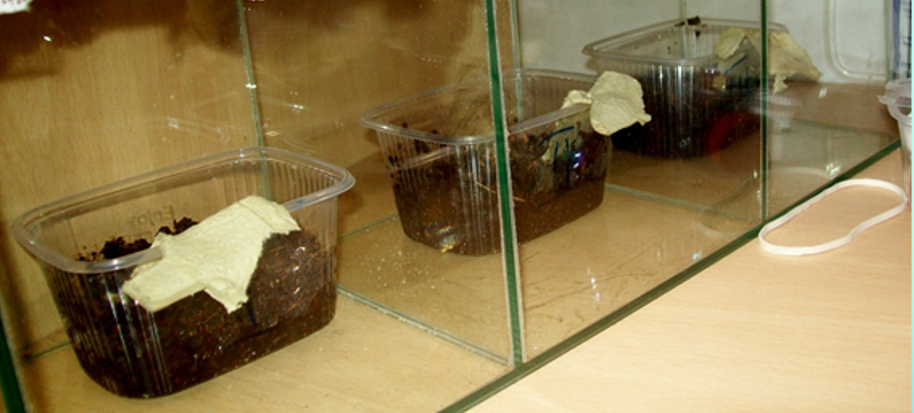Influence of ambient temperature on reproduction ofthe red-headed cricket (Gryllus assimilis)
DOI:
https://doi.org/10.55225/sti.403Słowa kluczowe:
insects, insectariums, environmental conditions,Abstrakt
Red-headed crickets were kept in glass insectariums equipped with drinkers, food containers and peat boxes for laying eggs. In the first stage of the experiment, the insects were divided into three groups, kept at 20°C, 25°C and 29°C, respectively. Three days after placing the crickets in the insectariums, the eggs were counted. In the second stage, the eggs (15 pcs.) were placed in boxes with peat in insectariums and exposed to the same temperatures as the females were kept at 20°C, 25°C and 29°C respectively, and the time in which the larvae hatch in each container was observed.
It was found that the thermal conditions of the environment influence the number of eggs laid by female Gryllus assimilis and the length of the embryonic period in red-headed crickets. It is estimated that in the temperature range of 20–29°C, increasing the temperature by 1°C shortens the time needed to hatch the larvae from the eggs by 2 days.
Statystyka pobrań
Bibliografia
Gorazdowski MJ, Kaczorowski M. Leksykon zwierząt terraryjnych. Warszawa: Multico Oficyna Wydawnicza; 2005: 42;7–9. Google Scholar
Khatun H, Claes J, Smets R, De Winne A, Akhtaruzzaman M, Van Der Borght M. Characterization of freeze-dried, oven-dried and blanched house crickets (Acheta domesticus) and Jamaican field crickets (Gryllus assimilis) by means of their physicochemical properties and volatile compounds. European Food Research and Technology. 2021;247(5):1291–1305. https://doi.org/10.1007/s00217-021-03709-x. DOI: https://doi.org/10.1007/s00217-021-03709-x Google Scholar
Finke MD, Dunham SU, Kwabi C. Evaluation of four dry commercial gut loading products for improving the calcium content of crickets, Acheta domesticus. Journal of Herpetological Medicine and Surgery. 2005;15(1):7–12. https://doi.org/10.5818/1529-9651.15.1.7. DOI: https://doi.org/10.5818/1529-9651.15.1.7 Google Scholar
Megido RC, Sabloni L, Geuensi M, Brostau Y, Alabii T, Blecker C, Drugmand D, Haubrugei E, Francisi F. Edible insects acceptance by Belgian consumers: Promising attitude for entomophagy development. Journal of Sensory Studies. 2014;29(1):14–20. https://doi.org/10.1111/joss.12077. DOI: https://doi.org/10.1111/joss.12077 Google Scholar
Dagevos H. A literature review of consumer research on edible insects: Recent evidence and new vistas from 2019 studies. Journal of Insects as Food and Feed. 2021;7(3):249–259. https://doi.org/10.3920/JIFF2020.0052. DOI: https://doi.org/10.3920/JIFF2020.0052 Google Scholar
Kędzior R. Bezkręgowce, In: Hędrzak M. et al. Zwierzęta moje hobby. Kraków: Wydawnictwo Kluszczyński; 2008. p. 34–37; 49. Google Scholar
Ebeling W. Urban entomology. [Internet] 2002. [cited 2015 Jan 11]. Available from: http://www.insects.ucr.edu/ebeling/ebel12.html. Google Scholar
Bellman H. Szarańczaki. Transl. M. Zadrąg. Warszawa: Multico Oficyna Wydawnicza; 2009. p. 10–11, 28, 165. Google Scholar
Jura C. Bezkręgowce: podstawy morfologii funkcjonalnej, systematyki i filogenezy. Warszawa: Wydawnictwo Naukowe PWN; 2002. p. 419–420, 589. Google Scholar
Wigglesworth V. Życie owadów. Transl. K. Domurat. Warszawa: Państwowe Wydawnictwo Rolnicze i Leśne; 1977. p. 25–31, 114–117, 316–317. Google Scholar
Błaszczak C. Zoologia: stawonogi. Warszawa: Wydawnictwo Naukowe PWN; 2012. p. 163–178. Google Scholar
Chapman RF. The insects structure and function. Cambridge: Cambridge University Press; 1998. p. 325, 334–336, 350, 365–366, 515–528. Google Scholar
Jurenka R. Insect physiology. Ames, IA: Iowa State University, Department of Entomology; 2011. Google Scholar
Kemsawasd V, Inthachat W, Suttisansanee U, Temviriyanukul P. Road to the red carpet of edible crickets through integration into the human food chain with biofunctions and sustainability: A review. International Journal of Molecular Sciences. 2022;23(3):1801. https://doi.org/10.3390/ijms23031801. DOI: https://doi.org/10.3390/ijms23031801 Google Scholar
Shuiten B. Zwierzęta w terrarium. Transl. J. Borycka-Zakrzewska. Warszawa: REA; 2011. p. 7–13. Google Scholar
Lewczuk T. Wpływ temperatury i rodzaju pokarmu na rozwój świerszcza domowego (Acheta domesticus) [Internet]. 2009. [cited 2022 June 5]. Available from: http://terrarium.com.pl/zobacz/wplyw-temperatury-i-rodzaju-pokarmu-na-rozwoj-swierszcza-domowego-acheta-domesticus-2326.html. Google Scholar
Adamo SA, Lovett MME. Some like it hot: The effects of climate change on reproduction, immune function and disease resistance in the cricket Gryllus texensis. The Journal of Experimental Biology. 2011;214:1997–2004. https://doi.org/10.1242/jeb.056531. DOI: https://doi.org/10.1242/jeb.056531 Google Scholar
Sun BJ, Huebner C, Treidel LA, Clark RM, Roberts KT, Kenagy GJ, Williams CM. Nocturnal dispersal flight of crickets: Behavioural and physiological responses to cool environmental temperatures. Functional Ecology. 2020;34(9):1907–1920. https://doi.org/10.1111/1365-2435.13615. DOI: https://doi.org/10.1111/1365-2435.13615 Google Scholar
Schmidt-Nielsen K. Fizjologia zwierząt: adaptacja do środowiska. Warszawa: Wydawnictwo Naukowe PWN; 2008. Google Scholar
Batcabe JP, Howell JD, Blomquist GJ, Borgeson CE. Effects of developmental age, ambient temperature, and dietary alterations on D12 desaturase activity in the house cricket, Acheta domesticus. Archives of Insect Biochemistry and Physiology. 2000;44(3):112–119. https://doi.org/10.1002/1520-6327(200007)44:3<112::AID-ARCH2>3.0.CO;2-L. DOI: https://doi.org/10.1002/1520-6327(200007)44:3<112::AID-ARCH2>3.0.CO;2-L Google Scholar
Lachenicht MW, Clusella-Trullas S, Boardman L, Le Roux C, Terblanche JS. Effects of acclimation temperature on thermal tolerance, locomotion performance and respiratory metabolism in Acheta domesticus L. (Orthoptera: Gryllidae), Journal of Insect Physiology. 2010;56(7):822–830. https://doi.org/10.1016/j.jinsphys.2010.02.010. DOI: https://doi.org/10.1016/j.jinsphys.2010.02.010 Google Scholar
Hedrick AV. Acoustic communication in insects and anurans: Common problems and diverse solutions. Integrative and Comparative Biology. 2002;42(5):1080–1080. https://doi.org/10.1093/icb/42.5.1080. DOI: https://doi.org/10.1093/icb/42.5.1080 Google Scholar
Beckers OM. Phenotypic plasticity related to temperature induces song variation in the field cricket Gryllus rubens. Ethology. 2020;126(8):781-790. https://doi.org/10.1111/eth.1303. DOI: https://doi.org/10.1111/eth.13035 Google Scholar
Bale JS. Hayward SAL. Insect overwintering in a changing climate. The Journal of Experimental Biology. 2009;213(6):980–994. https://doi.org/10.1242/jeb.037911. DOI: https://doi.org/10.1242/jeb.037911 Google Scholar
Hilszczański J, Jaworski T. Wpływ zmian temperatury i wilgotności na cykle rozwojowe i znaczenie owadów w ekosystemach leśnych w związku z prawdopodobnymi zmianami klimatycznymi. Leśne Prace Badawcze. 2013;74:345–355. Google Scholar
Limberger GM, Nery LEM, Fonseca DBD. Reproductive status modulates mortality rate, lifespan and egg production, but do not the physiological aging in the field cricket Gryllus assimilis (Fabricius, 1775) (Orthoptera: Gryllidae). Neotropical Entomology. 2021;50(2):237–246. https://doi.org/10.1007/s13744-020-00839-x. DOI: https://doi.org/10.1007/s13744-020-00839-x Google Scholar
Booth DT, Kiddell K. Temperature and the energetics of development in the house cricket (Acheta domesticus). Journal of Insect Physiology. 2007;53(9):950–953. https://doi.org/10.1016/j.jinsphys.2007.03.009. DOI: https://doi.org/10.1016/j.jinsphys.2007.03.009 Google Scholar
Shah AA, Wanapat M. Gryllus testaceus walker (crickets) farming management, chemical composition, nutritive profile, and their effect on animal digestibility. Entomological Research. 2021;51(12):639–649. https://doi.org/10.1111/1748-5967.12557. DOI: https://doi.org/10.1111/1748-5967.12557 Google Scholar

Pobrania
Opublikowane
Jak cytować
Numer
Dział
Licencja
Prawa autorskie (c) 2022 Natalia Hermansa, Kamil Kustra, Magdalena Trela, Marcin Lis

Utwór dostępny jest na licencji Creative Commons Uznanie autorstwa – Na tych samych warunkach 4.0 Miedzynarodowe.



